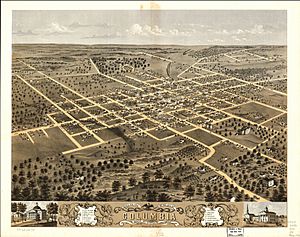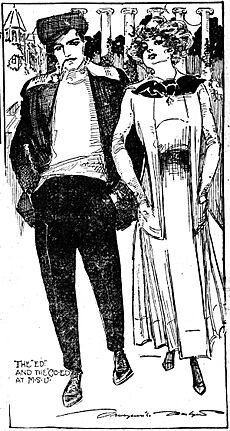History of Columbia, Missouri facts for kids

The city of Columbia, Missouri has a history that goes back over 200 years. Pioneers from Kentucky founded it in 1821. It became the main town, or county seat, for Boone County. Columbia's location on the important Boone's Lick Road helped it grow quickly. Many settlers traveled this road on their way west. Today, Columbia is Missouri's fourth largest city and a major center for education.
Contents
Early History of Columbia
Ancient Times and First Explorers
The area where Columbia now stands was once home to the Mississippian culture and the Mound Builders. When European explorers first arrived, the Osage and Missouri Native American groups lived here. In 1678, a French explorer named La Salle claimed all of Missouri for France. Later, in 1803, the famous Lewis and Clark Expedition passed by this area on the Missouri River.
How Columbia Was Founded
The story of Columbia begins with settlers from Kentucky and Virginia. They moved to a region called the Boonslick in the early 1800s. Before 1815, people lived in small log forts because of attacks from Native Americans during the War of 1812.
After the war, many more settlers arrived. They traveled by foot, horseback, and wagon along the Boone's Lick Road. Sometimes, they brought enslaved African Americans with them. By 1818, so many people had moved to the area that a new county was needed. This new county would be created from Howard County.
A group called the Smithton Land Company bought over 2,000 acres of land. They planned to build a village called Smithton. In 1819, Smithton was just a few log cabins in a forest. Richard Gentry, who would become Columbia's first mayor, had his cabin there.
In 1820, Boone County was officially formed. It was named after the explorer Daniel Boone. Commissioners were chosen to pick a permanent county seat. Smithton never grew very big, and it was hard to dig wells there.
So, in the spring of 1821, new springs were found nearby. The people of Smithton moved their cabins to this new spot. They named the new town Columbia, a historic name for the United States. The first house in Columbia was built by Thomas Duly in 1820. Columbia became the county seat in 1821, and the important Boone's Lick Road was rerouted through the town. This helped Columbia grow and become a lasting city.
Columbia Grows and Develops
Columbia's main strengths—education, medicine, and insurance—started very early. When the town was first planned, land was set aside for a state university. The University of Missouri was founded in 1839. When the state decided to build a university, Columbia raised a lot of money and donated land. This land is now the Francis Quadrangle.
Stephens College opened even earlier, in 1833. It was first known as the Columbia Female Academy. Other schools also started in Columbia, like Christian Female College, which is now Columbia College.
Columbia also benefited from being a stop for stagecoaches on the Santa Fe and Oregon trails. Later, the Missouri-Kansas-Texas Railroad came through. In 1822, the first hospital was set up by William Jewell. The first newspaper began in 1830, and the state's first theater opened in 1832. By 1839, Boone County was one of the wealthiest and most populated areas in Missouri, second only to St. Louis County.
Civil War and After
Columbia's buildings and roads were mostly safe during the Civil War. However, some big battles happened nearby. The town had many Union soldiers, and even though the city supported the Union, the areas around Boone County mostly supported the South. After the war, during a time called Reconstruction, Columbia continued to grow steadily in all directions.
Columbia in the 20th Century
In the 1900s, Columbia became even more important as an education center. It became home to the main offices of the University of Missouri System, Stephens College, and Columbia College.
Columbia also became a major transportation hub. U.S. Routes 63 and 40 (which is now part of Interstate 70) were built through the city. Soon after, the Columbia Regional Airport opened. During this time, two large insurance companies, Shelter Insurance and State Farm, set up their main offices in Columbia. By the end of the 20th century, Columbia's population had grown to over 80,000 people.
Recent Growth and Changes
In the early 2000s, Columbia started making plans to manage its continued growth. The city is still expanding, especially towards the Missouri River in the southwest part of Boone County. The downtown area remains a lively cultural center. It is also seeing a lot of new buildings for homes and businesses. The University of Missouri, which had a record number of students in 2006, is also building many new facilities.


